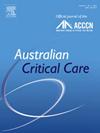Prevalence and complications of agitation between intensive care unit admission and tracheal extubation in adult cardiac surgery patients: A single-centre observational study
IF 2.7
3区 医学
Q2 CRITICAL CARE MEDICINE
引用次数: 0
Abstract
Background
Some patients admitted to the intensive care unit (ICU) after adult cardiac surgery develop agitation prior to tracheal extubation. The prevalence and consequences of such agitation remain unknown.
Objectives
The objectives were to study the prevalence and complications of agitation that occurs between ICU admission and prior to tracheal extubation.
Methods
A single-centre observational study was conducted from March 2021 to December 2023. Data were retrieved from the medical records of all adult patients with sedation ceased for tracheal extubation < 24 hours after ICU admission. Agitation prior to tracheal extubation was defined as a Richmond Agitation-Sedation Scale score ≥+2. Comparisons were made between agitated and nonagitated groups. All variables underwent descriptive analysis. For time-to-event outcomes, Cox regression was performed, while dichotomous outcomes were analysed using logistic regression.
Results
Seven hundred patient records were analysed. Agitation was identified in 204 (29%) patients. Patients with agitation had prolonged mechanical ventilation (mean: 25.7 hours, standard deviation [SD]: 41.1) compared to non-agitated patients (mean: 11.6 hours, SD: 15.6, hazard ratio: 0.50, 95% confidence interval [CI]: 0.42–0.59), and prolonged ICU stay (72.9 hours, SD: 66.1 compared to nonagitated patients (52.4 hours, SD: 60.7, hazard ratio: 0.68, 95% CI: 0.58–0.80). Sixty-four (31.4%) patients with agitation were referred to specialist pain services compared to 92 (18.5%) nonagitated patients (odds ratio [OR]: 2.00, 95% CI: 1.38–2.91). Delirium in the ICU developed in 48 (23.5%) patients with agitation, compared to 61 (12.3%) nonagitated patients (OR: 2.19, 95% CI: 1.44–3.34). After transfer to the ward, 70 (34.5%) patients with agitation and 114 (23%) nonagitated patients were diagnosed with delirium (OR: 0.57, 95% CI: 0.40–0.82).
Conclusion
Patients frequently developed agitation before extubation. All patients received mechanical ventilation, but the duration was prolonged in agitated patients, who also stayed in the ICU for longer, received more specialist pain services, and had a higher likelihood of delirium.
成人心脏手术患者在重症监护病房入住和气管拔管之间躁动的患病率和并发症:一项单中心观察研究
背景:一些成人心脏手术后入住重症监护病房(ICU)的患者在气管拔管前出现躁动。这种躁动的普遍程度和后果尚不清楚。目的研究患者在ICU入院至气管拔管前躁动的发生率及并发症。方法于2021年3月至2023年12月进行单中心观察性研究。数据来自于所有停止镇静拔管的成年患者的医疗记录;ICU入院后24小时。气管拔管前的躁动被定义为Richmond躁动-镇静量表评分≥+2。在激动组和非激动组之间进行比较。所有变量进行描述性分析。对于时间-事件结局,采用Cox回归,而二分结局采用逻辑回归进行分析。结果对700例患者病历进行分析。204例(29%)患者出现躁动。与非躁动患者相比,躁动患者机械通气时间延长(平均:25.7小时,标准差[SD]: 41.1)(平均:11.6小时,SD: 15.6,风险比:0.50,95%可信区间[CI]: 0.42-0.59), ICU住院时间延长(72.9小时,SD: 66.1,与非躁动患者相比(52.4小时,SD: 60.7,风险比:0.68,95% CI: 0.58-0.80)。64名躁动患者(31.4%)被转介到专科疼痛服务,而92名非躁动患者(18.5%)被转介到专科疼痛服务(优势比[OR]: 2.00, 95% CI: 1.38-2.91)。ICU中48例(23.5%)躁动患者出现谵妄,而61例(12.3%)非躁动患者出现谵妄(OR: 2.19, 95% CI: 1.44-3.34)。转入病房后,70名躁动患者(34.5%)和114名非躁动患者(23%)被诊断为谵妄(OR: 0.57, 95% CI: 0.40-0.82)。结论拔管前患者易出现躁动。所有患者均接受机械通气,但激动患者的持续时间延长,在ICU的时间更长,接受更多专科疼痛服务,谵妄的可能性更高。
本文章由计算机程序翻译,如有差异,请以英文原文为准。
求助全文
约1分钟内获得全文
求助全文
来源期刊

Australian Critical Care
NURSING-NURSING
CiteScore
4.90
自引率
9.10%
发文量
148
审稿时长
>12 weeks
期刊介绍:
Australian Critical Care is the official journal of the Australian College of Critical Care Nurses (ACCCN). It is a bi-monthly peer-reviewed journal, providing clinically relevant research, reviews and articles of interest to the critical care community. Australian Critical Care publishes peer-reviewed scholarly papers that report research findings, research-based reviews, discussion papers and commentaries which are of interest to an international readership of critical care practitioners, educators, administrators and researchers. Interprofessional articles are welcomed.
 求助内容:
求助内容: 应助结果提醒方式:
应助结果提醒方式:


